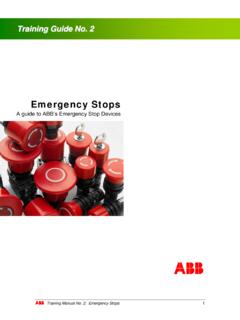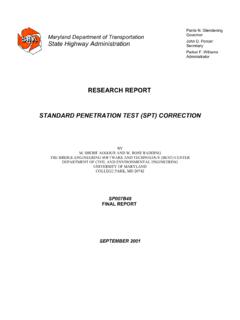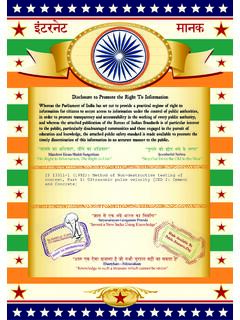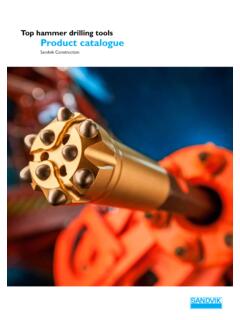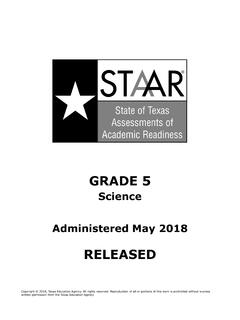Transcription of A. B.
1 1. For an object traveling in a straight line, its velocity (v, in m/s) as a function of time (t, in s) is given by the following graph. Which graph best depicts the object s momentum? A. B. C. D. E. 2. For an object traveling in a straight line, its velocity (v, in m/s) as a function of time (t, in s) is given by the following graph. Which graph best illustrates the object s acceleration? A. B. C. D. E. 3. For an object traveling in a straight line, its velocity (v, in m/s) as a function of time (t, in s) is given by the following graph. Which graph best depicts the object s kinetic energy? A. B. C. D. E. 4. For an object traveling in a straight line, its velocity (v, in m/s) as a function of time (t, in s) is given by the following graph. Which graph best illustrates the object s distance from its starting point?
2 A. B. C. D. E. 5. Which one is NOT a vector? A. Displacement B. Velocity C. Acceleration D. Linear momentum E. Kinetic energy 6. If an object s mass and the net force it feels are both known, then Newton s second law could be used to directly calculate which quantity? A. Displacement B. Velocity C. Acceleration D. Linear momentum E. Kinetic energy 7. Which quantity can be expressed in the same units as impulse? A. Displacement B. Velocity C. Acceleration D. Linear momentum E. Kinetic energy 8. If an object s speed is changing, which of the quantities could remain constant? A. Displacement B. Velocity C. Acceleration D. Linear momentum E. Kinetic energy 9. Which provides the basis for the observation that the universe is expanding? A. Newton s law of universal gravitation B. Red shift of light from other galaxies C.
3 The fact that every element of atomic number greater than 83 is radioactive D. The zeroth law of thermodynamics E. Mass energy equivalence 10. Which principle could be used to help calculate the amount of radiation emitted by a star? A. Newton s law of universal gravitation B. Red shift of light from other galaxies C. The fact that every element of atomic number greater than 83 is radioactive D. The zeroth law of thermodynamics E. Mass energy equivalence 11. Which is due to the change in wave speed when a wave strikes the boundary to another medium? A. Reflection B. Refraction C. Polarization D. Diffraction E. Interference 12. Which phenomenon is NOT experienced by sound waves? A. Reflection B. Refraction C. Polarization D. Diffraction E. Interference 13. An astronaut standing on the surface of the moon (mass = M, radius = R) holds a feather (mass = m) in one hand and a hammer (mass = 100m) in the other hand, both at the same height above the surface.
4 If he releases them simultaneously, what is the acceleration of the hammer ? A. B. C. D. E. 14. Two satellites orbit the earth. Their orbits are circular, and each satellite travels at a constant speed. If the mass of Satellite #2 is twice the mass of Satellite #1, which satellite s speed is greater? A. Satellite #1, by a factor of B. Satellite #1, by a factor of 2 C. Satellite #2, by a factor of D. Satellite #2, by a factor of 2 E. Neither; the satellites speeds are the same. 15. It refers to the collision of two blocks on a frictionless table. Before the collision, the block of mass m is at rest. What is the total momentum of the blocks just AFTER the collision? A. 12 kg-m/s B. 16 kg-m/s C. 18 kg-m/s D. 24 kg-m/s E. 32 kg-m/s 16. It refers to the collision of two blocks on a frictionless table. Before the collision, the block of mass m is at rest.
5 If the collision were elastic, what is the total kinetic energy of the blocks just AFTER the collision? A. 16 J B. 32 J C. 64 J D. 128 J E. 256 J 17. It refers to the collision of two blocks on a frictionless table. Before the collision, the block of mass m is at rest. If the blocks had instead stuck together after the collision, with what speed would they move if m = 12 kg ? A. m/s B. m/s C. m/s D. m/s E. m/s 18. The figure above shows two positively charged particles. The +Q charge is fixed in position, and the +q charge is brought close to +Q and released from rest. Which of the following graphs best depicts the acceleration (a) of the +q charge as a function of its distance (r) from +Q ? A. B. C. D. E. 19. Two particles have unequal charges; one is +q and the other is 2q. The strength of the electrostatic force between these two stationary particles is equal to F.
6 What happens to F if the distance between the particles is halved? A. It decreases by a factor of 4. B. It decreases by a factor of 2. C. It remains the same. D. It increases by a factor of 2. E. It increases by a factor of 4. 20. A simple harmonic oscillator has a frequency of Hz and an amplitude of m. What is the period of the oscillations? A. sec B. sec C. 8 sec D. 20 sec E. 50 sec 21. A light wave, traveling at 3 108 m/s has a frequency of 6 1015 Hz. What is its wavelength? A. 5 10 8 m B. 2 10 7 m C. 5 10 7 m D. 5 10 6 m E. 2 107 m 22. A beam of monochromatic light entering a glass window pane from the air will experience a change in A. frequency and wavelength B. frequency and speed C. speed and wavelength D. speed only E. wavelength only 23. Two cannons shoot cannonballs simultaneously.
7 The cannon embedded in the ground shoots a cannonball whose mass is half that of the cannonball shot by the elevated cannon. Also, the initial speed of the cannonball projected from ground level is half the initial speed of the cannonball shot horizontally from the elevated position. Air resistance is negligible and can be ignored. Each cannonball is in motion for more than 2 seconds before striking the level ground. Let a1 denote the acceleration of the cannonball of mass m one second after launch, and let a2 denote the acceleration of the cannonball of mass m/2 one second after launch. Which of the following statements is true? A. (A)a1= 4a2 B. (B)a1= 2a2 C. (C)a1= a2 D. (D)a2= 2a1 E. (E)a2= 4a1 24. Two cannons shoot cannonballs simultaneously. The cannon embedded in the ground shoots a cannonball whose mass is half that of the cannonball shot by the elevated cannon.
8 Also, the initial speed of the cannonball projected from ground level is half the initial speed of the cannonball shot horizontally from the elevated position. Air resistance is negligible and can be ignored. Each cannonball is in motion for more than 2 seconds before striking the level ground. If the cannonball projected from ground level is in flight for a total time of T, what horizontal distance does it travel? A. B. v0T C. D. E. v0 Tcos 0 25. Two cannons shoot cannonballs simultaneously. The cannon embedded in the ground shoots a cannonball whose mass is half that of the cannonball shot by the elevated cannon. Also, the initial speed of the cannonball projected from ground level is half the initial speed of the cannonball shot horizontally from the elevated position. Air resistance is negligible and can be ignored.
9 Each cannonball is in motion for more than 2 seconds before striking the level ground. For the cannonball of mass m, which of the following quantities decreases as the cannonball falls to the ground? A. Kinetic energy B. Potential energy C. Momentum D. Speed E. Mass 26. Which of the following statements is true concerning phase changes? A. When a liquid freezes, it releases thermal energy into its immediate environment. B. When a solid melts, it releases thermal energy into its immediate environment. C. For most substances, the latent heat of fusion is greater than the latent heat of vaporization. D. As a solid melts, its temperature increases. E. As a liquid freezes, its temperature decreases. 27. Four point charges are labeled Charge 1, Charge 2, Charge 3, and Charge 4. It is known that Charge 1 attracts Charge 2, Charge 2 repels Charge 3, and Charge 3 attracts Charge 4.
10 Which of the following must be true? A. Charge 1 attracts Charge 4. B. Charge 2 attracts Charge 3. C. Charge 1 repels Charge 3. D. Charge 2 repels Charge 4. E. Charge 1 repels Charge 4. 28. All six resistors in the circuit have the same resistance, R, and the battery is a source of constant voltage, V. How does the current through Resistor a compare with the current through Resistor b ? A. The current through Resistor a is 9 times the current through Resistor b. B. The current through Resistor a is 3 times the current through Resistor b. C. The current through Resistor a is the same as the current through Resistor b. D. The current through Resistor b is 3 times the current through Resistor a. E. The current through Resistor b is 9 times the current through Resistor a. 29. All six resistors in the circuit have the same resistance, R, and the battery is a source of constant voltage, V.










